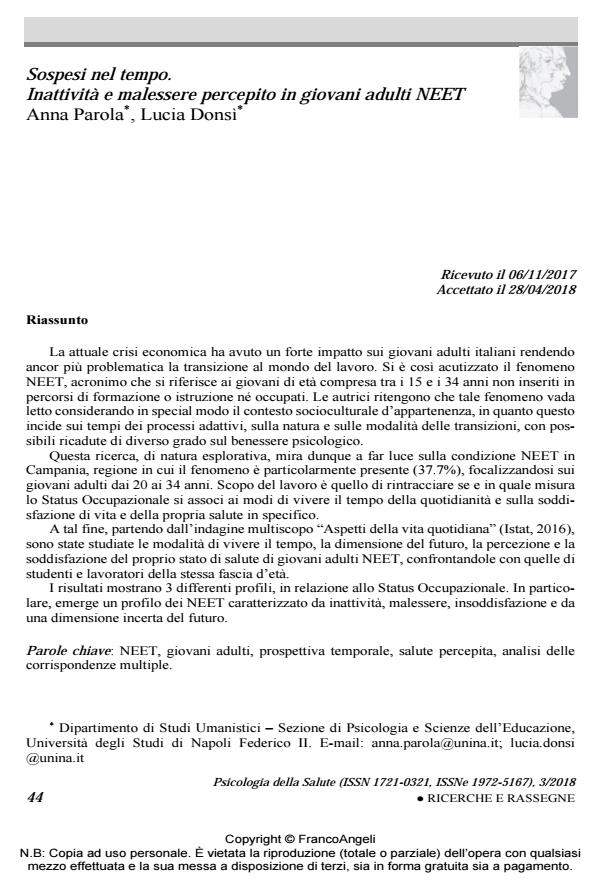Sospesi nel tempo. Inattività e malessere percepito in giovani adulti NEET
Titolo Rivista PSICOLOGIA DELLA SALUTE
Autori/Curatori Anna Parola, Lucia Donsì
Anno di pubblicazione 2018 Fascicolo 2018/3
Lingua Italiano Numero pagine 30 P. 44-73 Dimensione file 446 KB
DOI 10.3280/PDS2018-003003
Il DOI è il codice a barre della proprietà intellettuale: per saperne di più
clicca qui
Qui sotto puoi vedere in anteprima la prima pagina di questo articolo.
Se questo articolo ti interessa, lo puoi acquistare (e scaricare in formato pdf) seguendo le facili indicazioni per acquistare il download credit. Acquista Download Credits per scaricare questo Articolo in formato PDF

FrancoAngeli è membro della Publishers International Linking Association, Inc (PILA)associazione indipendente e non profit per facilitare (attraverso i servizi tecnologici implementati da CrossRef.org) l’accesso degli studiosi ai contenuti digitali nelle pubblicazioni professionali e scientifiche
La attuale crisi economica ha avuto un forte impatto sui giovani adulti italiani rendendo ancor più problematica la transizione al mondo del lavoro. Si è così acutizzato il fenomeno NEET, acronimo che si riferisce ai giovani di età compresa tra i 15 e i 34 anni non inseriti in percorsi di formazione o istruzione né occupati. Le autrici ritengono che tale fenomeno vada letto considerando in special modo il contesto socioculturale d’appartenenza, in quanto questo incide sui tempi dei processi adattivi, sulla natura e sulle modalità delle transizioni, con possibili ricadute di diverso grado sul benessere psicologico. Questa ricerca, di natura esplorativa, mira dunque a far luce sulla condizione NEET in Campania, regione in cui il fenomeno è particolarmente presente (37.7%), focalizzandosi sui giovani adulti dai 20 ai 34 anni. Scopo del lavoro è quello di rintracciare se e in quale misura lo Status Occupazionale si associ ai modi di vivere il tempo della quotidianità e sulla sod-disfazione di vita e della propria salute in specifico. A tal fine, partendo dall’indagine multiscopo "Aspetti della vita quotidiana" (Istat, 2016), sono state studiate le modalità di vivere il tempo, la dimensione del futuro, la percezione e la soddisfazione del proprio stato di salute di giovani adulti NEET, confrontandole con quelle di studenti e lavoratori della stessa fascia d’età. I risultati mostrano 3 differenti profili, in relazione allo Status Occupazionale. In parti-colare, emerge un profilo dei NEET caratterizzato da inattività, malessere, insoddisfazione e da una dimensione incerta del futuro.
Parole chiave:NEET, giovani adulti, prospettiva temporale, salute percepita, analisi delle corrispondenze multiple.
- Novel Coronavirus Outbreak and Career Development: A Narrative Approach Into the Meaning for Italian University Graduates Anna Parola, in Frontiers in Psychology 2255/2020
DOI: 10.3389/fpsyg.2020.02255 - Youth unemployment and health outcomes: the moderation role of the future time perspective Anna Parola, Jenny Marcionetti, in International Journal for Educational and Vocational Guidance /2022 pp.327
DOI: 10.1007/s10775-021-09488-x - The effects of a non-adaptive school-to-work transition on transition to adulthood, time perspective and internalizing and externalizing problems Anna Parola, Jenny Marcionetti, Luigia Simona Sica, Lucia Donsì, in Current Psychology /2023 pp.25855
DOI: 10.1007/s12144-022-03605-x - Mental Health Through the COVID-19 Quarantine: A Growth Curve Analysis on Italian Young Adults Anna Parola, Alessandro Rossi, Francesca Tessitore, Gina Troisi, Stefania Mannarini, in Frontiers in Psychology 567484/2020
DOI: 10.3389/fpsyg.2020.567484 - The Anxiety-Buffer Hypothesis in the Time of COVID-19: When Self-Esteem Protects From the Impact of Loneliness and Fear on Anxiety and Depression Alessandro Rossi, Anna Panzeri, Giada Pietrabissa, Gian Mauro Manzoni, Gianluca Castelnuovo, Stefania Mannarini, in Frontiers in Psychology 2177/2020
DOI: 10.3389/fpsyg.2020.02177 - Life Design for Youth as a Creativity-Based Intervention for Transforming a Challenging World Luca Fusco, Anna Parola, Luigia Simona Sica, in Frontiers in Psychology 662072/2021
DOI: 10.3389/fpsyg.2021.662072 - Vocational identity flexibility and psychosocial functioning in Italian high school students Luca Fusco, Luigia Simona Sica, Anna Parola, Laura Aleni Sestito, in International Journal of School & Educational Psychology /2022 pp.144
DOI: 10.1080/21683603.2020.1841050 - Clinical Psychological Figures in Healthcare Professionals: Resilience and Maladjustment as the “Cost of Care” Emanuele Maria Merlo, Anca Pantea Stoian, Ion G. Motofei, Salvatore Settineri, in Frontiers in Psychology 607783/2020
DOI: 10.3389/fpsyg.2020.607783 - Text Analytics Cristiano Felaco, Anna Parola, pp.29 (ISBN:978-3-030-52679-5)
- The Storm Doesn’t Touch me!—The Role of Perceived Employability of Students and Graduates in the Pandemic Era Gerardo Petruzziello, Rita Chiesa, Marco Giovanni Mariani, in Sustainability /2022 pp.4303
DOI: 10.3390/su14074303 - Macro-Determinants of NEET: An Ecological Study at the Country Level of Analysis for the Period 1997–2020 Simone Amendola, in Youth /2022 pp.384
DOI: 10.3390/youth2030028
Anna Parola, Lucia Donsì, Sospesi nel tempo. Inattività e malessere percepito in giovani adulti NEET in "PSICOLOGIA DELLA SALUTE" 3/2018, pp 44-73, DOI: 10.3280/PDS2018-003003